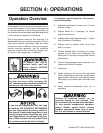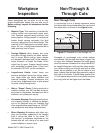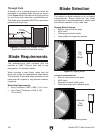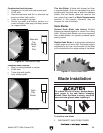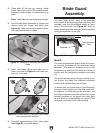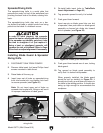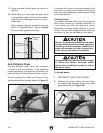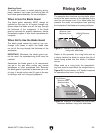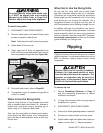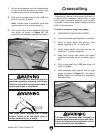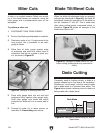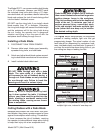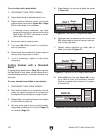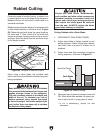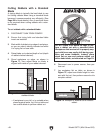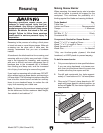
-34-
Model G0771 (Mfd. Since 8/15)
Do not use the riving knife with a dado blade
that has a diameter smaller than 10" in diameter.
Otherwise, the riving knife height will exceed the
blade height and the workpiece will hit the riving
knife during the cut, forcing the operator into a
dangerous situation of trying to turn the saw off
with the workpiece stuck halfway through the cut.
In addition, although it is possible to use the riv-
ing knife for through cutting operations, the blade
guard assembly offers far more injury protection
and risk reduction than the riving knife. Therefore,
we strongly recommend that you use the blade
guard assembly for through cuts.
When Not to Use the Riving Knife
To make a rip cut:
1. Review Preventing Kickback on Page 11
and take necessary precautions to reduce
likelihood of kickback.
2. If using natural wood, joint one long edge of
workpiece on a jointer.
3. DISCONNECT SAW FROM POWER!
4. Ensure that blade guard/spreader is installed.
5. Set fence to desired width of cut on scale.
6. Adjust blade height so highest saw tooth pro-
trudes no more than
1
⁄4" above workpiece.
"Ripping" means cutting with the grain of a natural
wood workpiece. In man-made materials such as
MDF or plywood, ripping simply means cutting
lengthwise.
Ripping
Serious injury can be caused by kickback.
Kickback is a high-speed ejection of stock
from the table saw toward an operator. The
operator or bystanders may be struck by
flying stock, or the operator’s hands can be
pulled into the blade during kickback.
To ensure that the riving knife works safe-
ly, it MUST be aligned with and correctly
adjusted to the blade. Refer to Page 63 to
check or adjust the riving knife alignment.
To install riving knife:
1. DISCONNECT SAW FROM POWER!
2. Remove table insert, but leave Phillips head
screws mounted in table throat.
Note: Table insert is held in place by magnet.
3. Raise blade all the way up.
4. Insert upper set of holes on spreader/riving
knife into bracket slot and tighten lock lever to
secure spreader/riving knife (see Figure 59).
When to Use the Riving Knife
Use the riving knife for all non-through cuts made
with a standard table saw blade (i.e., dadoes or
rabbet cuts, and when using a tenoning jig), or
when using a 10" diameter dado blade.
Also, use the riving knife for those special opera-
tions where the blade guard or its components
get in the way of safe operation, such as with very
narrow cuts.
5. Re-install table insert (refer to Page 66).
6. Tug upward on top of spreader/riving knife to
verify it is locked.
Figure 59. Lock lever used to secure spreader.
Lock Lever
Bracket Slot
Spreader/
Riving Knife
Upper Holes



